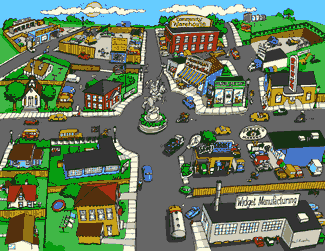Welcome to Recycle City!
Just a few years ago, this place was called Dumptown, but now like many other communities they have a Zero Waste goal to reduce waste and greenhouse gas emissions. For years, the folks living here hadn't thought much about where their food, toys, and other possessions came from - or where they went when they threw them out. And, eventually, that became a very BIG problem...
During the Dumptown days, people who lived outside the city also used their dump. They didn't know what happened to waste after it was thrown away. They thought nothing of dropping empty soda cans here and there or putting cans of leftover paint right into their trash cans. They bought and dumped more and more every year.
Things that easily could have been reused or recycled were tossed in the trash, because nobody knew recycling made a difference. At the dump, they threw dangerous chemicals and poisons (hazardous waste) into the regular garbage (solid waste).
The garbage heap grew and began to smell. Sometimes it caught fire sending toxic smoke into the air and making it hard for everyone to breathe. Some Dumptowners moved away from the mess, but most couldn't move or change jobs.
The Dumptowners who stayed were exposed to pollution for long periods of time and suffered from many different illnesses. The people who lived, worked, and played in Dumptown got sicker than those in other communities. This was unfair – it was an environmental justice problem. Dumptown is made up mostly of people of color, and some of them are low income. Communities of color and low-income communities in the United States are impacted more by environmental justice issues.
Everybody in Dumptown knew they had to fix it.
They sorted the waste at the dump and found out most of it was coming from towns outside of Dumptown, so they worked on reducing waste at home and worked with the other towns to reduce their waste too.
They started by reducing the amount of waste they threw away at home. They avoided items at the store that came in extra packaging and asked the companies to stop using wasteful single-use containers for their products. They learned to reuse useful items — like washing out food-safe containers to store their food in instead of throwing them away.
They also learned to recycle and compost. They set up bins around town to collect glass, paper, plastics, and aluminum that could be converted back into raw materials to make new products. They turned their food scraps and yard trimmings into compost to grow their gardens and save water. They made recycling and composting signs for the bins in different languages and added pictures to make it easy to recycle right.
By reducing waste, everyone in the city helped reduce the need for new materials, so they saved energy and reduced greenhouse gas emissions that cause climate change. They also worked together to share what they learned with other towns that used the dump so they would reduce waste and adopt Zero Waste goals.
Dumptowners paid special attention to reducing the toxic materials they bought, such as trying safer pest control products or household cleaners. For the hazardous products they did buy, Dumptown set up special collection locations where people could drop off used chemicals, paints, and cleansers for safe handling and proper disposal.
Eventually, they were able to close the old city dump. Outside of town, they built a new anaerobic digester, that can turn food waste into renewable energy for the city, and a new solid waste landfill. With the town's new image, it needed a new name, and Recycle City was born. Travel around Recycle City to find out what folks are doing -- and what you can do -- to reduce waste and make the environment better.




